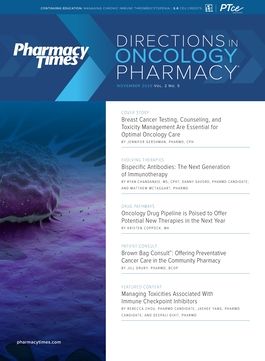Publication
Article
Pharmacy Practice in Focus: Oncology
Essential Updates in Acute Graft-Versus-Host Disease
In a live 2020 Directions in Oncology Pharmacy® conference session, an update on research in the past decade that has led to improvements in the diagnosis, risk stratification, prevention, and treatment of acute graft-versus-host disease was provided.
PTCE would like to acknowledge Incyte Corporation for their generous support of pharmacist education.
In a live 2020 Directions in Oncology Pharmacy® conference session titled Acute Graft- Versus-Host Disease: Innovative Strategies in Risk Assessment, Prevention, and Treatment, Katie S. Gatwood, PharmD, BCOP, provided an update on research in the past decade that has led to improvements in the diagnosis, risk stratification, prevention, and treatment of acute graft-versus-host disease (aGVHD). Approximately 30,000 patients undergo allogeneic hematopoietic stem cell transplant (HSCT) annually in the United States, with approximately 20% to 85% developing aGVHD that affects the skin, gut, or liver.
Dr Gatwood reviewed the clinical presentation, risk factors, and pathophysiology of aGVHD before diving into the Minnesota aGVHD risk score, a recently developed model to better predict patient response to therapy, survival, and transplant-related mortality. The role of biomarkers to help discern patients at high risk for development of aGVHD was discussed, as well as the likelihood of response to front-line therapy and the risk of death from aGVHD. Dr Gatwood explained how, historically, regimens to prevent GVHD consisted of a calcineurin inhibitor with additional immunosuppressants (eg, methotrexate, mycophenolate, sirolimus, antithymocyte globulin). The successful use of post-transplant cyclophosphamide (PTCy) to prevent aGVHD in patients with a haploidentical donor led to investigation of PTCy in patients with a matched-related donor (MRD) or matched-unrelated donor (MUD). Dr Gatwood summarized clinical trials in allogeneic HSCT patients with an MRD and MUD. The use of PTCy in various stem cell sources was also discussed: Patients receiving peripheral blood as a stem cell source may have an unacceptably high rate of aGVHD, although the incidence may be lessened with additional immunosuppression. The use of PTCy in patients receiving bone marrow as the stem cell source is associated with acceptable rates of aGVHD and low rates of chronic GVHD.
Dr Gatwood then highlighted treatment strategies for aGVHD, noting initial therapy often consists of topical and/or systemic corticosteroids. The results of the BMT CTN 1501 study were reviewed, noting that sirolimus did not improve aGVHD outcomes compared with prednisone. Sirolimus was associated with a higher rate of thrombotic microangiopathy and cytomegalovirus reactivation and a lower rate of hyperglycemia compared with traditional steroid therapy. Dr Gatwood explained that fewer than 50% of patients treated with steroids will achieve a complete response and second-line therapy is often required, which led to discussion of the phase 3 REACH2 trial, comparing ruxolitinib to investigator’s choice for the treatment of steroid-refractory aGVHD. Investigators could select from the following therapies before randomization: extracorporeal photopheresis, antithymocyte globulin, etanercept, infliximab, sirolimus, or tocilizumab. More patients receiving ruxolitinib achieved a response at day 28, leading to a higher rate of failure-free survival. Adverse effects led to treatment discontinuation in 11% of patients treated with ruxolitinib and 5% of patients receiving investigator’s choice.
Dr Gatwood concluded the presentation by providing clinical pearls for pharmacists managing immunosuppressive therapies, and described appropriate bacterial, fungal, viral, and opportunistic infection prophylaxis for patients with aGVHD.







